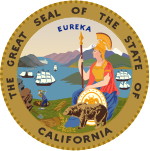
Back هيئة كاليفورنيا التشريعية Arabic California State Legislature German Legislatura Estatal de California Spanish California Osariigi Seadusandlik Kogu Estonian Kalifornian lainsäädäntöelin Finnish Législature d'État de la Californie French Legislatur Negara Bagian California ID Legislatura statale della California Italian カリフォルニア州議会 Japanese 캘리포니아 주의회 Korean
California State Legislature | |
|---|---|
| 2023–24 session | |
 | |
| Type | |
| Type | |
| Houses | Senate (upper) Assembly (lower) |
Term limits | 12 years |
| History | |
New session started | December 5, 2022 |
| Leadership | |
Senate Republican Leader | |
Assembly Minority Leader | |
| Structure | |
| Seats | 120 40 Senators 80 Assemblymembers |
 | |
Senate political groups |
|
 | |
Assembly political groups |
|
| Elections | |
Last Senate election | November 8, 2022 (20 seats) |
Last Assembly election | November 8, 2022 |
Next Senate election | November 5, 2024 (20 seats) |
Next Assembly election | November 5, 2024 |
| Meeting place | |
 | |
| California State Capitol Sacramento | |
| Website | |
| leginfo | |
| Constitution | |
| Constitution of California | |
| Rules | |
| Joint Rules of the Senate and Assembly | |
38°34′36″N 121°29′36″W / 38.576572°N 121.493411°W




The California State Legislature is the bicameral state legislature of the U.S. state of California, consisting of the California State Assembly (lower house with 80 members) and the California State Senate (upper house with 40 members).[1] Both houses of the Legislature convene at the California State Capitol in Sacramento.
The California State Legislature is one of ten full-time state legislatures in the United States.[2] The houses are distinguished by the colors of the carpet and trim of each house: the Senate uses red and the Assembly uses green, inspired by the United Kingdom's House of Lords and House of Commons respectively.[3]
The Democratic Party currently holds veto-proof supermajorities in both houses of the California State Legislature.[4] The Assembly consists of 62 Democrats and 17 Republicans, while the Senate is composed of 31 Democrats and 9 Republicans. Except for a brief period from 1995 to 1996, the Assembly has been in Democratic hands since the 1970 election. The Senate has been under Democratic control since 1970, except for a brief period from 1973 to 1975.
- ^ "California Constitution Article IV § 2". California Office of Legislative Counsel. Archived from the original on February 24, 2019. Retrieved February 23, 2019.
- ^ ""Full- and Part-time Legislatures"". Archived from the original on March 7, 2018. Retrieved December 6, 2018.
- ^ "Assembly & Senate | California State Capitol Museum". Archived from the original on September 12, 2022. Retrieved September 12, 2022.
- ^ Gstalter, Morgan (November 12, 2018). "Dems gain veto-proof supermajority in California legislature". The Hill. Archived from the original on April 6, 2020. Retrieved December 2, 2019.